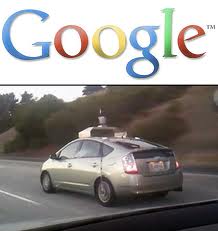Categories
 Have you ever wanted a car that could drive itself? Google’s (GOOG) latest project brings hardware and software together to create a self driving car. Time Magazine Recently Put it on it’s 50 Best Inventions of 2010 List. The vehicle created by Google has already traveled 140,000 miles safely on its own.
Have you ever wanted a car that could drive itself? Google’s (GOOG) latest project brings hardware and software together to create a self driving car. Time Magazine Recently Put it on it’s 50 Best Inventions of 2010 List. The vehicle created by Google has already traveled 140,000 miles safely on its own.
Google says the one of a kind vehicle is not meant to replace drivers but to help them. Imagine being able to take your hands off the wheel for a minute to check an email or take a phone call. This would be an amazing feature to have on a vehicle, especially when traveling long distances, or when you are in in unfamiliar areas or have children in the car. An engineer from Google described it as “Super Cruise Control,” a way to drastically improve your driving experience rather than replace driving altogether.
There is also hope that this new technology will reduce the amount of traffic accidents and therefore increase driving safety. Today thousands of people die each year in traffic accidents. Besides safety, this vehicle will be efficient so it will reduce vehicle emissions and reduces our dependence on fossil fuels and can also help to ease traffic congestion.
The Google vehicle relies on cameras and a scanning laser to do the driving. You can just tell the vehicle your destination and it will navigate the best route for you, taking into consideration speed limits, traffic patterns and other obstacles. Unfortunately the vehicle tracking technology is no where near being ready to market.
To see a video test drive of the Google Car Click Here.
According to CNN, thanks to the the financial resources and creativity of Google, driverless vehicle tracking technology is moving toward mass-market application sooner than anyone predicted – in the same manner that Internet technology migrated from university laboratories to personal computers once it was embraced by companies like AOL.
Auto manufacturers have long known that cars could be built to drive themselves, but have been cautious about overselling the idea to the public or predicting their imminent arrival. In the meantime, automakers have developed a raft of features to mitigate driver distraction, which ultimately could be used to take driving out of human hands. What Google brings to the table is an outsider’s perspective and an understanding of tech-savvy consumers.
“The industry knows the long road that has to be traveled to make driverless technology successful,” said Tom Kowaleski, a spokesman for BMW’s U.S. operations.
Safety and litigation worries by the industry have previously slowed the introduction of features now considered basic, such as airbags. Conventional wisdom has held that no machine could process as much information as a driver or react as well – but the time may have finally come where perhaps the opposite is true. “Every new piece of technology we introduce takes three to five years of gestation before it can be introduced. I have no crystal ball,” Kowaleski said.
While Google’s latest experimental vehicle tracking uses sensors to see its surroundings and respond appropriately, BMW, Toyota and other automakers have been experimenting with a different kind of technology: Their experiments revolve around communication systems that allow cars to exchange wireless signals. A car that encounters a slippery road, for example, could inform others approaching the area, Kowaleski said. In an early stage of the technology, the driver could respond to a warning; eventually cars could be taught to respond on their own by slowing down or engaging all wheel drive or some other feature.
Toyota was the first automaker to offer a feature that allowed a driver to overcome the difficulty of parallel parking by letting the car do so on its own. John Hanson, a Toyota spokesman, said in an emailed message that the automaker has been working on autonomous vehicles and related technologies and “will be a leader” when such vehicles are introduced.
Beyond the technological hurdles, which seem less difficult to surmount as companies like Google weigh in, automakers may have to consider a different model for personal transportation once a human driver is no longer essential. Here’s where the technology might both empower consumers and startle car makers.
Cars that don’t need drivers also may not need private owners – since they could be summoned remotely and returned once their journey is complete. Why take on a lease if you can purchase a subscription to a car instead? Netflix (NFLX) has already soundly proven that consumers will change their habits if enough of an incentive is provided. Car owners who never want to spend a Saturday under the hood or in the waiting room of a mechanic’s shop again might quickly adapt to a car subscription model.
With Google’s driverless leap forward, both in terms of technology and in presentation to an increasingly tech-savvy and tech-obsessed world, the joys of car driving and car ownership may give way to the convenience of forgoing the gasoline pump — or the charging station — for good.










 Back to Blogs
Back to Blogs


